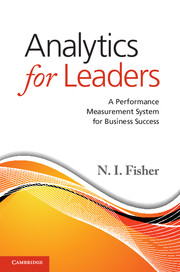Book contents
- Frontmatter
- Dedication
- Contents
- List of exhibits
- Preface
- Acknowledgments
- 1 How’s your due diligence?
- 2 Introduction to the system
- 3 A framework for performance measurement
- 4 What is Stakeholder Value?
- 5 Adding Value for Customers
- 6 Adding Value for People
- 7 Adding Value for Partners
- 8 Adding Value for the Community
- 9 Adding Value for the Owners
- 10 What to report and how to report it
- 11 How to get started . . .
- 12 The Performance Measurement Framework: Assessment and adoption
- 13 Practical aspects of managing Stakeholder Value
- 14 Performance measurement for Small and Medium Enterprises
- Appendix Don’t be fooled by statistics
- References
- Index
3 - A framework for performance measurement
Published online by Cambridge University Press: 05 December 2013
- Frontmatter
- Dedication
- Contents
- List of exhibits
- Preface
- Acknowledgments
- 1 How’s your due diligence?
- 2 Introduction to the system
- 3 A framework for performance measurement
- 4 What is Stakeholder Value?
- 5 Adding Value for Customers
- 6 Adding Value for People
- 7 Adding Value for Partners
- 8 Adding Value for the Community
- 9 Adding Value for the Owners
- 10 What to report and how to report it
- 11 How to get started . . .
- 12 The Performance Measurement Framework: Assessment and adoption
- 13 Practical aspects of managing Stakeholder Value
- 14 Performance measurement for Small and Medium Enterprises
- Appendix Don’t be fooled by statistics
- References
- Index
Summary
We intend to conduct our business in a way that not only meets but exceeds the expectations of our customers, business partners, shareholders, and creditors, as well as the communities in which we operate and society at large.
Akira MoriPREAMBLE ON DEVELOPING MEASUREMENT STRATEGIES
How do we work out what sorts of measures are needed to help run an enterprise? We’ll use three methods.
One reasonable starting point is to decide on some principles for selecting performance measures. It’s not only reasonable, it’s important because poorly chosen measures can distort people’s behavior, with disastrous and expensive consequences, as we’ll see shortly.
Then there’s a simple way of thinking about how to identify measures that can help you find your way, even in the foggiest circumstances. It’s the Tribus Paradigm, named after a very clear and practical thinker about management: Myron Tribus.
Finally, it’s important to recognize that there’s a hierarchy amongst performance measures: indeed, the Tribus Paradigm leads us inexorably to a performance measurement structure.
So that’s the Framework that will now be developed: a set of Principles for selecting measures, a Paradigm for thinking about which performance measures are needed, and a structure for performance measures.
- Type
- Chapter
- Information
- Analytics for LeadersA Performance Measurement System for Business Success, pp. 19 - 34Publisher: Cambridge University PressPrint publication year: 2013



